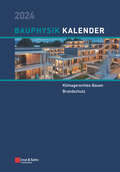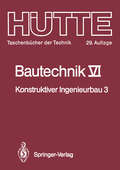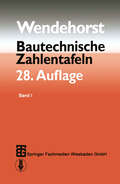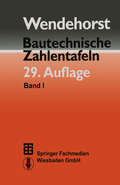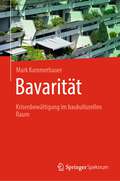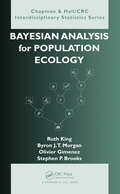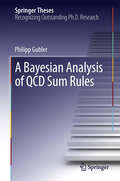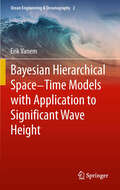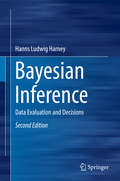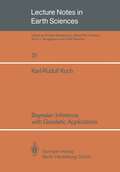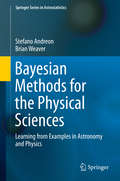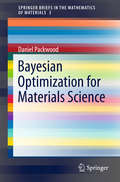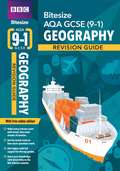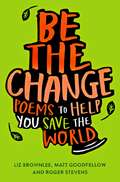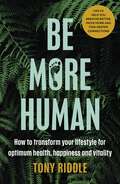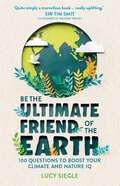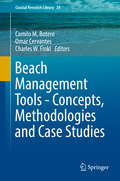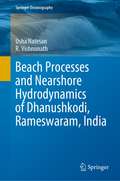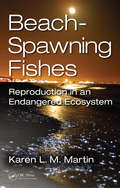- Table View
- List View
Bauphysik-Kalender 2024: Schwerpunkte: Klimagerechtes Bauen; Brandschutz (Bauphysik-Kalender-eBundle (Ernst & Sohn))
by Nabil A. FouadDer Bauphysik-Kalender 2024 gibt Praxishinweise für die klimagerechte Planung von Gebäuden, aber auch von urbanen Räumen. Diese sind durch die hohen Verdichtungen und Versiegelungen besonders anfällig gegenüber der Klimaveränderung mit häufigeren Extremwetterereignissen. Aber sie sind gestaltbare Orte, an denen durch eine interdisziplinäre und zukunftsorientierte Planung eine weitere Verschärfung des Klimawandels gebremst und die Resilienz von Mensch, Flora und Fauna gegenüber seinen Folgen gestärkt werden kann. Das Buch bietet aktuelles Wissen um bauphysikalische Prozesse zu verstehen, Potenziale von Konstruktionen gezielt auszuschöpfen und die Gebäudetechnik und Automatisierung funktional zu halten. Außerdem werden Tools und Nachweisverfahren getestet und kommentiert, mit deren Hilfe Bilanzen über die Umweltwirkungen von Gebäuden bzw. Bewertungen der Klimaanpassung von Gebäuden ermittelt werden können. Der zweite diesjährige Schwerpunkt Brandschutz widmet sich der Holzbauweise sowie der Untersuchung von Brandeinwirkungen durch E-Fahrzeuge und kraftstoffbetriebene Fahrzeuge in Parkgaragen. Der Bauphysik-Kalender 2024 bietet eine solide Arbeitsgrundlage und ein verlässliches aktuelles Nachschlagewerk für die Planung in Neubau und Bestand, alle Kapitel bewegen sich nahe an der Ingenieurpraxis. Das Buch enthält Planungshinweise, Konzepte und Praxisbeispiele.
Bautechnik: Konstruktiver Ingenieurbau 3: Massiv- und Stahlbau (Hütte - Taschenbücher der Technik #6)
by K. W. Bieger J. Lierse J. Lindner J. RothBautechnische Zahlentafeln
by WendehorstDer "Wendehorst", seit nun nahezu 65 Jahren unentbehrliches Standardwerk für die Bautechnik, wurde für die 28. Auflage wiederum nach den neuesten DIN-Normen und technischen Regelwerken unter Berücksichtigung der Europäischen Normung (Eurocode) aktualisiert. Die Eurocodes entwickeln sich derzeit nur langsam weiter und eine europaweite Einführung ist erst mittelfristig in Sicht. Aktueller Trend ist, für eine Übergangszeit nationale Normen zu schaffen, die auf dem Neuen Sicherheitskonzept mit Teilsicherheitsbeiwerten beruhen. Kurz vor der Einführung steht hier die DIN 1045-1 bis -3, deren Teil 1 für die 28. Auflage nun im Entwurf bereits berücksichtigt ist, damit die Ingenieure sich schon heute auf diese zukünftige Herausforderung vorbereiten können. Erstmals liegt dem "Wendehorst" eine CD-ROM mit einer Beispielsammlung aus dem Bereich Statik und Festigkeitslehre bei, die den angehenden Ingenieuren das Verständnis für dieses schwierige und komplexe Fach anhand durchgerechneter Beispiele erleichtern wird. - Zusätzlich ist dem Buch eine 20seitige Beilage beigefügt, die die CD-ROM ergänzt und in der die Zustandsfunktionen nach den Elastizitätstheorien 1. und 2. Ordnung am Beispiel von Einfeldträgersystemen vorgestellt werden.
Bautechnische Zahlentafeln
by Reinhard WendehorstDer "Wendehorst" ist seit 66 Jahren das unentbehrliche Standardwerk der Bautechnik für Studium und Praxis und wurde für die 29. Auflage vollständig neu bearbeitet sowie aktualisiert. Das Kapitel Bauzeichnungen enthält die neuen DIN ISO 128-20 und DIN EN ISO 4157-1 bis 3 und im Kapitel Beton und Stahlbeton wurden die E DIN 4160 und E DIN 4226-1 eingearbeitet. Die beiliegende CD enthält neben einer Beispielesammlung zum Thema Statik und Festigkeitslehre ein umfassendes Softwarepaket, das fast alle Bereiche des Bauwesens, mit Schwerpunkt Baustatik, abdeckt. Die 20-seitige Beilage enthält zusätzliche Beispiele aus der Statik und stellt die Zustandsfunktionen nach den Elastizitätstheorien 1. und 2. Ordnung am Beispiel von Einfeldträger-systemen vor.
Bavarität: Krisenbewältigung im baukulturellen Raum
by Mark KammerbauerDas Buch befasst sich mit der Architektur, dem Städtebau und der Stadtplanung im Freistaat Bayern aus interdisziplinärer, urbanistischer Sicht. Damit verbundene baukulturelle Partizipation kann zur Bewältigung von Krisen beitragen, wenn sowohl Akteure der Planung und Gestaltung als auch der Nutzung berücksichtigt werden. Ziel des Buches ist, den gebauten Raum Bayerns zu lesen und zu verstehen, ihn einer Kritik zu unterziehen, dabei die Erfolge nicht auszublenden, um Lösungen zu präsentieren und um schließlich Raum für die Reflexion und das Imaginieren zu "bauen". Wenn Menschen die gebaute Umwelt lesen und verstehen, dann informiert das auch ihr Handeln, insbesondere, wenn sie partizipativ an Planungs- und Gestaltungsprozessen für die Errichtung des gebauten Raums beteiligt sind. Um diese Phänomene ihrem Kontext entsprechend zu fassen und zu deuten, schlägt das Buch den Begriff der Bavarität vor. Im Fall des Freistaats Bayern und seines ländlich-städtischen Kontinuums als Ergebnis historischer baulich-räumlicher Entwicklung, durch Tradition und Moderne konturiert, stellt Bavarität eine sozio-kulturelle Leistung dar, deren Ergebnis in der Partizipation aller Beteiligten gründet und nicht endet.
Bayesian Analysis for Population Ecology
by Ruth King Byron Morgan Olivier Gimenez Steve BrooksNovel Statistical Tools for Conserving and Managing PopulationsBy gathering information on key demographic parameters, scientists can often predict how populations will develop in the future and relate these parameters to external influences, such as global warming. Because of their ability to easily incorporate random effects, fit state-space mode
A Bayesian Analysis of QCD Sum Rules (Springer Theses)
by Philipp GublerThe author develops a novel analysis method for QCD sum rules (QCDSR) by applying the maximum entropy method (MEM) to arrive at an analysis with less artificial assumptions than previously held. This is a first-time accomplishment in the field.In this thesis, a reformed MEM for QCDSR is formalized and is applied to the sum rules of several channels: the light-quark meson in the vector channel, the light-quark baryon channel with spin and isospin 1/2, and several quarkonium channels at both zero and finite temperatures. This novel technique of combining QCDSR with MEM is applied to the study of quarkonium in hot matter, which is an important probe of the quark-gluon plasma currently being created in heavy-ion collision experiments at RHIC and LHC.
Bayesian Hierarchical Space-Time Models with Application to Significant Wave Height (Ocean Engineering & Oceanography #2)
by Erik VanemThis book provides an example of a thorough statistical treatment of ocean wave data in space and time. It demonstrates how the flexible framework of Bayesian hierarchical space-time models can be applied to oceanographic processes such as significant wave height in order to describe dependence structures and uncertainties in the data.This monograph is a research book and it is partly cross-disciplinary. The methodology itself is firmly rooted in the statistical research tradition, based on probability theory and stochastic processes. However, that methodology has been applied to a problem in the field of physical oceanography, analyzing data for significant wave height, which is of crucial importance to ocean engineering disciplines. Indeed, the statistical properties of significant wave height are important for the design, construction and operation of ships and other marine and coastal structures. Furthermore, the book addresses the question of whether climate change has an effect of the ocean wave climate, and if so what that effect might be. Thus, this book is an important contribution to the ongoing debate on climate change, its implications and how to adapt to a changing climate, with a particular focus on the maritime industries and the marine environment. This book should be of value to anyone with an interest in the statistical modelling of environmental processes, and in particular to those with an interest in the ocean wave climate. It is written on a level that should be understandable to everyone with a basic background in statistics or elementary mathematics, and an introduction to some basic concepts is provided in the appendices for the uninitiated reader. The intended readership includes students and professionals involved in statistics, oceanography, ocean engineering, environmental research, climate sciences and risk assessment. Moreover, the book’s findings are relevant for various stakeholders in the maritime industries such as design offices, classification societies, ship owners, yards and operators, flag states and intergovernmental agencies such as the IMO.
Bayesian Inference: Data Evaluation and Decisions
by Hanns Ludwig HarneyThis new edition offers a comprehensive introduction to the analysis of data using Bayes rule. It generalizes Gaussian error intervals to situations in which the data follow distributions other than Gaussian. This is particularly useful when the observed parameter is barely above the background or the histogram of multiparametric data contains many empty bins, so that the determination of the validity of a theory cannot be based on the chi-squared-criterion. In addition to the solutions of practical problems, this approach provides an epistemic insight: the logic of quantum mechanics is obtained as the logic of unbiased inference from counting data. New sections feature factorizing parameters, commuting parameters, observables in quantum mechanics, the art of fitting with coherent and with incoherent alternatives and fitting with multinomial distribution. Additional problems and examples help deepen the knowledge. Requiring no knowledge of quantum mechanics, the book is written on introductory level, with many examples and exercises, for advanced undergraduate and graduate students in the physical sciences, planning to, or working in, fields such as medical physics, nuclear physics, quantum mechanics, and chaos.
Bayesian Inference with Geodetic Applications (Lecture Notes in Earth Sciences #31)
by Karl-Rudolf KochThis introduction to Bayesian inference places special emphasis on applications. All basic concepts are presented: Bayes' theorem, prior density functions, point estimation, confidence region, hypothesis testing and predictive analysis. In addition, Monte Carlo methods are discussed since the applications mostly rely on the numerical integration of the posterior distribution. Furthermore, Bayesian inference in the linear model, nonlinear model, mixed model and in the model with unknown variance and covariance components is considered. Solutions are supplied for the classification, for the posterior analysis based on distributions of robust maximum likelihood type estimates, and for the reconstruction of digital images.
Bayesian Machine Learning in Geotechnical Site Characterization (Challenges in Geotechnical and Rock Engineering)
by Jianye ChingBayesian data analysis and modelling linked with machine learning offers a new tool for handling geotechnical data. This book presents recent advancements made by the author in the area of probabilistic geotechnical site characterization.Two types of correlation play central roles in geotechnical site characterization: cross-correlation among soil properties and spatial-correlation in the underground space. The book starts with the introduction of Bayesian notion of probability “degree of belief”, showing that well-known probability axioms can be obtained by Boolean logic and the definition of plausibility function without the use of the notion “relative frequency”. It then reviews probability theories and useful probability models for cross-correlation and spatial correlation. Methods for Bayesian parameter estimation and prediction are also presented, and the use of these methods demonstrated with geotechnical site characterization examples.Bayesian Machine Learning in Geotechnical Site Characterization suits consulting engineers and graduate students in the area.
Bayesian Machine Learning in Geotechnical Site Characterization (Challenges in Geotechnical and Rock Engineering)
by Jianye ChingBayesian data analysis and modelling linked with machine learning offers a new tool for handling geotechnical data. This book presents recent advancements made by the author in the area of probabilistic geotechnical site characterization.Two types of correlation play central roles in geotechnical site characterization: cross-correlation among soil properties and spatial-correlation in the underground space. The book starts with the introduction of Bayesian notion of probability “degree of belief”, showing that well-known probability axioms can be obtained by Boolean logic and the definition of plausibility function without the use of the notion “relative frequency”. It then reviews probability theories and useful probability models for cross-correlation and spatial correlation. Methods for Bayesian parameter estimation and prediction are also presented, and the use of these methods demonstrated with geotechnical site characterization examples.Bayesian Machine Learning in Geotechnical Site Characterization suits consulting engineers and graduate students in the area.
Bayesian Methods for the Physical Sciences: Learning from Examples in Astronomy and Physics (Springer Series in Astrostatistics #4)
by Stefano Andreon Brian WeaverStatistical literacy is critical for the modern researcher in Physics and Astronomy. This book empowers researchers in these disciplines by providing the tools they will need to analyze their own data. Chapters in this book provide a statistical base from which to approach new problems, including numerical advice and a profusion of examples. The examples are engaging analyses of real-world problems taken from modern astronomical research. The examples are intended to be starting points for readers as they learn to approach their own data and research questions. Acknowledging that scientific progress now hinges on the availability of data and the possibility to improve previous analyses, data and code are distributed throughout the book. The JAGS symbolic language used throughout the book makes it easy to perform Bayesian analysis and is particularly valuable as readers may use it in a myriad of scenarios through slight modifications.This book is comprehensive, well written, and will surely be regarded as a standard text in both astrostatistics and physical statistics.Joseph M. Hilbe, President, International Astrostatistics Association, Professor Emeritus, University of Hawaii, and Adjunct Professor of Statistics, Arizona State University
Bayesian Optimization for Materials Science (SpringerBriefs in the Mathematics of Materials #3)
by Daniel PackwoodThis book provides a short and concise introduction to Bayesian optimization specifically for experimental and computational materials scientists. After explaining the basic idea behind Bayesian optimization and some applications to materials science in Chapter 1, the mathematical theory of Bayesian optimization is outlined in Chapter 2. Finally, Chapter 3 discusses an application of Bayesian optimization to a complicated structure optimization problem in computational surface science.Bayesian optimization is a promising global optimization technique that originates in the field of machine learning and is starting to gain attention in materials science. For the purpose of materials design, Bayesian optimization can be used to predict new materials with novel properties without extensive screening of candidate materials. For the purpose of computational materials science, Bayesian optimization can be incorporated into first-principles calculations to perform efficient, global structure optimizations. While research in these directions has been reported in high-profile journals, until now there has been no textbook aimed specifically at materials scientists who wish to incorporate Bayesian optimization into their own research. This book will be accessible to researchers and students in materials science who have a basic background in calculus and linear algebra.
BBC Bitesize AQA GCSE (BBC Bitesize GCSE 2017)
by Michael ChilesExam Board: AQA Academic Level: GCSE (9-1) Subject: Geography First Teaching: September 2015 First Exams: Summer 2017 For students, parents and teachers working with the new (9-1) GCSEs Who need help, or need to provide help for students, in revising for the new assessments BBC Bitesize 2017 consists of Revision Guides and Workbooks directly tailored to the studentsÕ needs Offers a great choice in revision materials and a unique digital experience_ Make every minute count with timed, bite-sized chunks of revision. Get the inside track on how exam questions work. Aim higher with full support for the top grades. Boost your knowledge with direct links to the BBC Bitesize website. __With free online edition_
Be The Change: Poems to help you save the world
by Roger Stevens Liz Brownlee Matt GoodfellowFrom National Poetry Day Ambassadors Liz Brownlee, Matt Goodfellow and Roger Stevens comes an incredible anthology of poetry identifying ways we can Be the Change. These positive and upbeat poems will explore sustainability and the positive efforts being made to protect the planet and are perfect for starting conversations about looking after each other and our environment.
Be More Human: How to transform your lifestyle for optimum health, happiness and vitality
by Tony Riddle'Tony Riddle's mission is to present ways of living that are more in sync with our human biology, to help us thrive in this modern world' Dr Rangan Chatterjee'This book is brilliant with such an important message' The Happy Pear ___________________________The ultimate guide to boosting your mental and physical health by reconnecting with the way we, as humans, were supposed to live, eat, sleep, breathe and move.The bright lights, late nights and constant hustle of our modern world have detached us from the way we, as humans, were supposed to live, connect and thrive. Be More Human explores the importance of reconnecting with our natural state and help us learn how to meet our true needs and live more naturally. Tony Riddle (@thenaturallifestylist) will explore how the majority of us do not sit, breathe, eat, sleep or move as nature intended and so we're actively going against our biology. This book will help us all to reassess our habits and tap back into our natural rhythms and ways of being to optimise our mental and physical wellbeing, reduce stress, sit correctly, breathe better and improve our quality of sleep.Tony is committed to helping us reconnect with how we were built to live in a way that can be incorporated into our hectic, modern lifestyles. His expertise will make this a transformative, empowering and practical guide to getting back in tune with a happier, healthier self to discover physical, emotional, mental and spiritual strength and wellbeing.We can't all live in nature, but we can all live more naturally and learn how to thrive instead of just survive.___________________________'Inspiring read' Rich Roll, author of Finding Ultra'Vital stuff' Bruce Parry
Be the Ultimate Friend of the Earth: 100 Questions to Boost Your Climate and Nature IQ
by Lucy Siegle‘This is a quite simply a marvellous book. I couldn’t find a trace of po-faced sanctimony nor yet the patronising tones of an expert attempting to speak to mortals. The conversational style – the beguiling marriage between accessible science and conspiratorial whispers which make it OK not to know everything – is really uplifting ... may everyone get the rush of pleasure from it that I have done.’ Sir Tim Smit, co-founder of the Eden Project'As someone who is passionate about nature and a proud eco nerd, I love this book and you will too!' Ellie Goulding, singer-songwriter and UN Environment Ambassador_______________________________________How much do you know about the state of our planet and the journey we’re on to reach a more sustainable future? Journalist and broadcaster Lucy Siegle tackles ten big topics involved in our quest to reach net zero and, through stories and revealing questions, probes your understanding of what we can all do to get there.Divided into ten important topics, and including revealing questions on recycling and reusing, the importance of flora and fauna and planet-friendly food, find out how much you really know about how our consumer habits and lifestyles are affecting the environment, and the positive changes we can make now to ensure we're all true friends of the earth. Packed full of stories and tips that show the people, the projects and the places that are already living as if this planet was precious, this is an essential handbook for anyone looking to improve their understanding of how we can all have a positive impact on Planet Earth.
Beach Composition (large print)
by RnibThis is a cross section image of a beach. An image border surrounds the image. There is a locator dot shown, which will be at the top left of the page when the image is the correct way up. There is a cliff in the top left of the page and a small section of sea in the bottom right of the page. The sea is shown at low tide. The sand of the beach goes from the left of the page at the bottom of the cliff across to the right next to the sea. Down from the sand is rock. The level of the high tide is marked by a horizontal dotted line. Where it meets the beach it makes a ridge of sand and small stones called a berm. The sea sorts the beach material out with finer particles on the lower beach and larger particles higher up the beach. The largest particles form a storm beach at the very top of the beach above the high tide line. They are deposited by the powerful surge and waves of a violent storm.
Beach Composition (UEB contracted)
by RnibThis is a cross section image of a beach. An image border surrounds the image. There is a locator dot shown, which will be at the top left of the page when the image is the correct way up. There is a cliff in the top left of the page and a small section of sea in the bottom right of the page. The sea is shown at low tide. The sand of the beach goes from the left of the page at the bottom of the cliff across to the right next to the sea. Down from the sand is rock. The level of the high tide is marked by a horizontal dotted line. Where it meets the beach it makes a ridge of sand and small stones called a berm. The sea sorts the beach material out with finer particles on the lower beach and larger particles higher up the beach. The largest particles form a storm beach at the very top of the beach above the high tide line. They are deposited by the powerful surge and waves of a violent storm.
Beach Composition (UEB uncontracted)
by RnibThis is a cross section image of a beach. An image border surrounds the image. There is a locator dot shown, which will be at the top left of the page when the image is the correct way up. There is a cliff in the top left of the page and a small section of sea in the bottom right of the page. The sea is shown at low tide. The sand of the beach goes from the left of the page at the bottom of the cliff across to the right next to the sea. Down from the sand is rock. The level of the high tide is marked by a horizontal dotted line. Where it meets the beach it makes a ridge of sand and small stones called a berm. The sea sorts the beach material out with finer particles on the lower beach and larger particles higher up the beach. The largest particles form a storm beach at the very top of the beach above the high tide line. They are deposited by the powerful surge and waves of a violent storm.
Beach Management Tools - Concepts, Methodologies and Case Studies (Coastal Research Library #24)
by Camilo M. Botero Omar Cervantes Charles W. FinklThis book provides an overview of beach management tools, including carrying capacity, beach nourishment, environmental and tourism awards (like Blue Flag or others), bathing water quality, zoning, beach typologies, quality index, user's perception, interdisciplinary beach monitoring, coastal legislation, shore protection, social and economic indicators, ecosystem services, and coastal governance (applied in beach case studies). Beaches are one of the most intensely used coastal ecosystems and are responsible for more than half of all global tourism revenues, and as such the book introduces a wide range of state-of-the-art tools that can be used to deal with a variety of beach challenges. Each chapter features specific types of tools that can be applied to advantage in beach management practices. With examples of local and regional case studies from around the globe, this is a valuable resource for anyone involved in beach management.
Beach Processes and Nearshore Hydrodynamics of Dhanushkodi, Rameswaram, India (Springer Oceanography)
by Usha Natesan R. VishnunathThis book focuses on understanding the shoreline dynamics, nearshore processes and sediment transport around Rameswaram Island and the cities of Dhanushkodi and Arichamunai. Rameswaram Island is located between the Gulf of Mannar on the south and Palk Bay on the north, between the southern tip of India and Sri Lanka, and is unique in terms of physical, chemical and biological processes. The Gulf of Mannar is established as a marine biodiversity conservation area by its richness of variety and variability of marine species such as corals, finfish, shellfish and other fishes. The island is predominantly influenced by four seasons: northeast monsoon, post-monsoon, summer and southwest monsoon; and the sedimentological and hydrodynamic conditions significantly change seasonally, resulting in the island’s responding in a different manner with each season. It also explains the physical forces and their impacts around these areas. Rameswaram Island has existed naturally for a long period of time even under the influence of different water masses of the Gulf of Mannar and Palk Bay. Understanding the regional natural phenomena is the only solution to carry out the best management practices to develop coastal constructions and modifications.
Beach Renourishment (SpringerBriefs in Earth Sciences)
by Eric Bird Nick LewisBeach renourishment is the restoration of beaches that have been depleted. The text deals with the sources of beach sediment as well as the causes and typical responses to beach erosion, before discussion of beach renourishment.Some of the first documented renourishment projects were undertaken in the early 1900’s on the east coast of the United States. Several countries have since renourished beaches, particularly during the past few decades. Most projects have been in the United States, the United Kingdom, some European countries and Australia. These are reviewed and experience from various beach renourishment projects used for discussion of the following topics:1. The need for preliminary investigations2. Sources of sediment for beach renourishment3. Methods of beach renourishment4. Design considerations5. Monitoring changes after beach renourishment6. Assessment of performance7. Modelling of beach renourishment8. Beach renourishment for coast protection9. Environmental impacts10. Costs and benefits11. Response of renourished beaches to a rising sea level
Beach-Spawning Fishes: Reproduction in an Endangered Ecosystem
by Karen L.M. MartinBeach-spawning fishes from exotic locations on most continents of the world provide spectacular examples of extreme adaptations during the most vulnerable life cycle stages. The beauty, intriguing biology, and importance of these charismatic fishes at the interface of marine and terrestrial ecosystems have inspired numerous scientific studies. Adap
